In 1868, many Lakota leaders of the Sioux nation agreed to a treaty, known as the Fort Laramie Treaty that created a large reservation for them in the western half of present-day South Dakota. They agreed to give up their nomadic life, which often brought them into conflict with other tribes in the region, with settlers, and with railroad surveyors, in exchange for a more stationary life relying on government-supplied subsidies. However, some Lakota leaders such as Sitting Bull and Crazy Horse rejected the reservation system. Likewise, many roving bands of hunters and warriors did not sign the 1868 treaty and consequently felt no obligation to conform to its restrictions or to limit their hunting to the unseeded hunting land assigned by the treaty. Their sporadic forays off the designated lands continually brought them into conflict with settlers and enemy tribes outside the treaty boundaries.
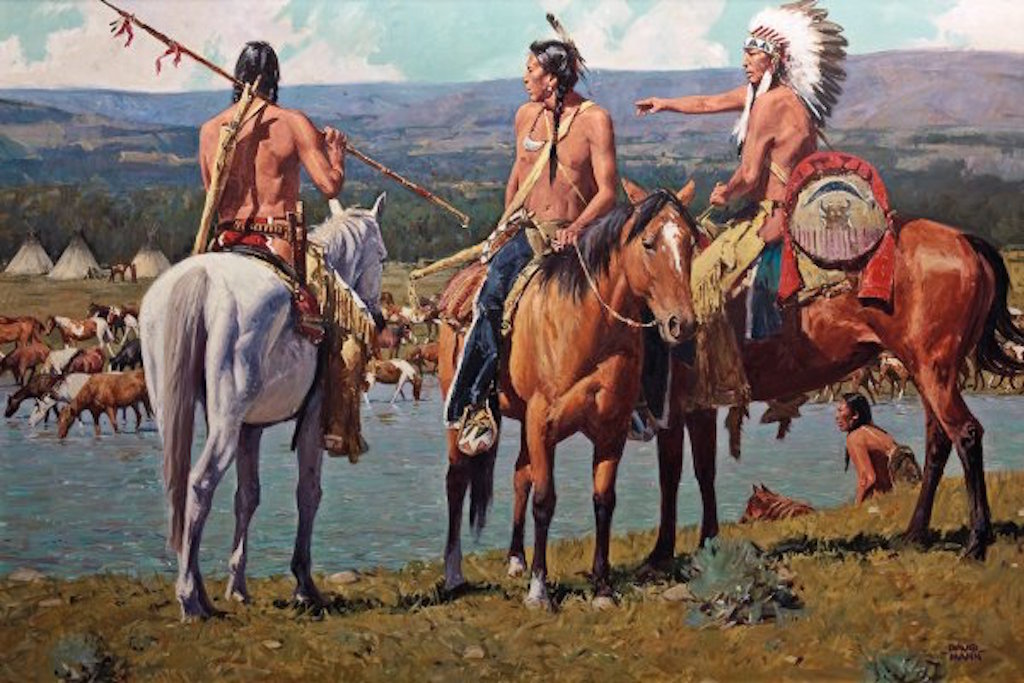
Custer Enters the Black Hills as Tensions Escalate
In 1874, the tension between the U.S. and the Lakota escalated when U.S. Army troops were ordered to explore the Black Hills inside the boundary of the Great Sioux Reservation. Their duties were to map the area, locate a suitable site for a future military post, and to make note of the natural resources. During the expedition, professional geologists discovered deposits of gold. Word of the discovery of mineral wealth created a gold rush of miners and entrepreneurs to the Black Hills in direct violation of the treaty of 1868. The U.S. negotiated with the Lakota to purchase the Black Hills, but the offered price was rejected. The climax came in the winter of 1875 when the Commissioner of Indian Affairs issued an ultimatum requiring all Sioux to report to the reservation by January 31, 1876. The deadline came with virtually no response from the natives, and matters were handed to the military, leading to the Great Sioux War of 1876.
Gen. Philip Sheridan, controversial Civil War general (for engineering the scorched earth strategy in the Shenandoah Valley that was instrumental in demoralizing and defeating the Confederacy), and commander of the Military Division of the Missouri, devised a strategy that committed several thousand troops to locate and attack the “renegade” Plains tribes of Lakota Sioux and Cheyenne – who were now considered “hostile” – and force their return to the Great Sioux Reservation. The campaign was set into motion in March 1876, when the Montana column, a 450-man force of combined cavalry and infantry commanded by Col. John Gibbon, marched out of Fort Ellis near Bozeman Montana. In the middle of May, a second force of 879 men commanded by Gen. Alfred Terry marched from Fort Abraham Lincoln, Bismarck, Dakota Territory, with a command comprised mostly of Lt. Col. George Armstrong Custer’s 7th Cavalry. During the last week of May, a third force of about 1,000 cavalry and infantry commanded by Gen. George Crook was launched from Fort Fetterman in central Wyoming.
It was expected that any one of these three forces would be able to deal with the 800-1,500 warriors they were likely to encounter. The three commands of Gibbon, Terry, and Crook were not expected to launch a coordinated attack on a specific Indian village at a known location. Inadequate, slow, and often unpredictable communications hampered any real coordination of the Army’s expeditionary forces. Furthermore, the nomadic hunting lifestyle of the Sioux and their Cheyenne allies had them constantly on the move. No officer or scout could be certain how long a village might remain stationary, or which direction the tribe might choose to go in search of food, water, and grazing areas for their horses.

The tribes, mostly Lakota Sioux, Northern Cheyenne, and Arapaho, came together in the region of the Powder, Rosebud, Bighorn, and Yellowstone rivers because it was a well-watered and productive hunting ground. But near the end of each spring, they also gathered there in large numbers for their annual Sun Dance ceremony. During their 1876 ceremony, which occurred around June 5 near present-day Lame Deer, Montana, just two weeks prior to their fateful meeting with Custer, Sitting Bull received a vision of soldiers falling upside down into his village. He prophesied there soon would be a great victory for his people.
Custer Advances as the Army’s Strategy Fractures
On June 22, Gen. Terry decided to detach Custer and his 7th Cavalry to make a wide flanking march and approach the Indians from the east and south. Custer was to act as the hammer and prevent the Lakota and their Cheyenne allies from slipping away and scattering, a common fear expressed by government and military authorities. Terry and Col. Gibbon, with infantry and cavalry, would approach from the north to act as a blocking force or anvil in support of Custer’s far-ranging movements toward the headwaters of the Tongue and Little Bighorn Rivers. The Indians, who were thought to be camped somewhere along the Little Bighorn River, “would be so completely enclosed as to make their escape virtually impossible.” This grievous underestimation of the native forces led to what we now know as Custer’s Last Stand, or the Battle of the Little Bighorn, otherwise known to the Lakota and other Plains Indians as the Battle of the Greasy Grass, so-named for the “greasy” appearance of the grass in the waters near the battle site.
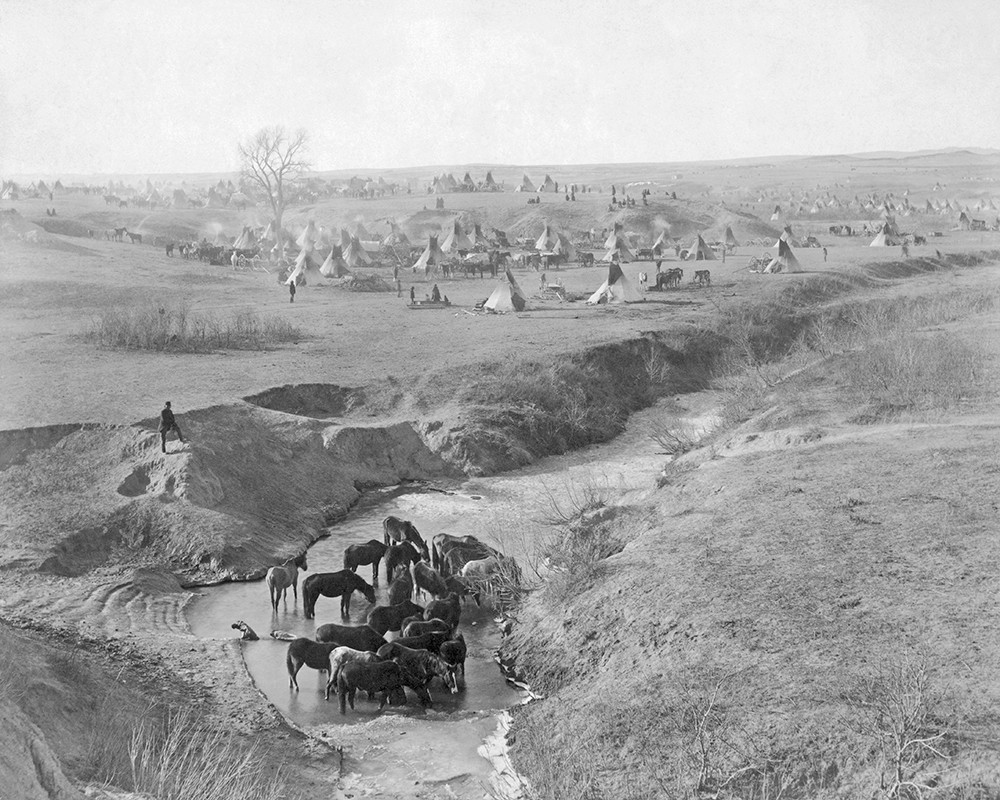
On the evening of June 24, Custer established a night camp twenty-five miles east of where the fateful battle would take place on June 25-26. The Crow and Arikara scouts were sent ahead, seeking actionable intelligence about the direction and location of the gathered Lakota and Cheyenne. The returning scouts reported that the trial indicated that the village had turned west toward the Little Bighorn River and was encamped about twenty-five miles west of the June 24 camp. Custer ordered a night march that followed the route that the village took as it crossed to the Little Bighorn River valley.
Early on the morning of June 25, the 7th Cavalry Regiment was positioned near the Wolf Mountains about 12-15 miles distant from the Lakota/Cheyenne encampment along the Little Bighorn River. The encampment, estimated to number about 8,000 with a warrior force of 1,500-1,800 men, was rife with rumors about soldiers on the other side of the Wolf Mountains, yet few were concerned. In the words of Low Dog, an Oglala Sioux, “I did not think anyone would come and attack us as strong as we were.”

Custer’s initial plan had been to conceal his regiment in the Wolf Mountains through June 25th, which would allow his Crow and Arikara scouts time to locate the Sioux and Cheyenne village. Custer then planned to make a night march, and launch an attack at dawn on June 26; however, the scouts reported the regiment’s presence had been detected by Lakota or Cheyenne warriors. Custer, judging the element of surprise to have been lost, feared the inhabitants would attack or scatter into the rugged landscape and cause the Army’s campaign to fail. Custer ordered an immediate advance to engage the village and its warrior force. His orders were to locate the Sioux encampment in the Big Horn Mountains of Montana and trap them until reinforcements arrived.
At the Wolf Mountain location, Custer ordered a division of the regiment into four segments: the pack train with ammunition and supplies, a three company force (125) commanded by Capt. Frederick Benteen, a three company force (140) commanded by Maj. Marcus Reno and a five company force (210) commanded by Custer. Benteen was ordered to march southwest, on a left oblique, with the objective of locating any Indians, “pitch into anything” he found, and send word to Custer. Custer and Reno’s advance placed them in proximity to the village, but still out of view. When it was reported that the village was scattering, Custer ordered Reno to lead his 140 man battalion, plus the Arikara scouts, and to “pitch into what was ahead” with the assurance that he would “be supported by the whole outfit.”
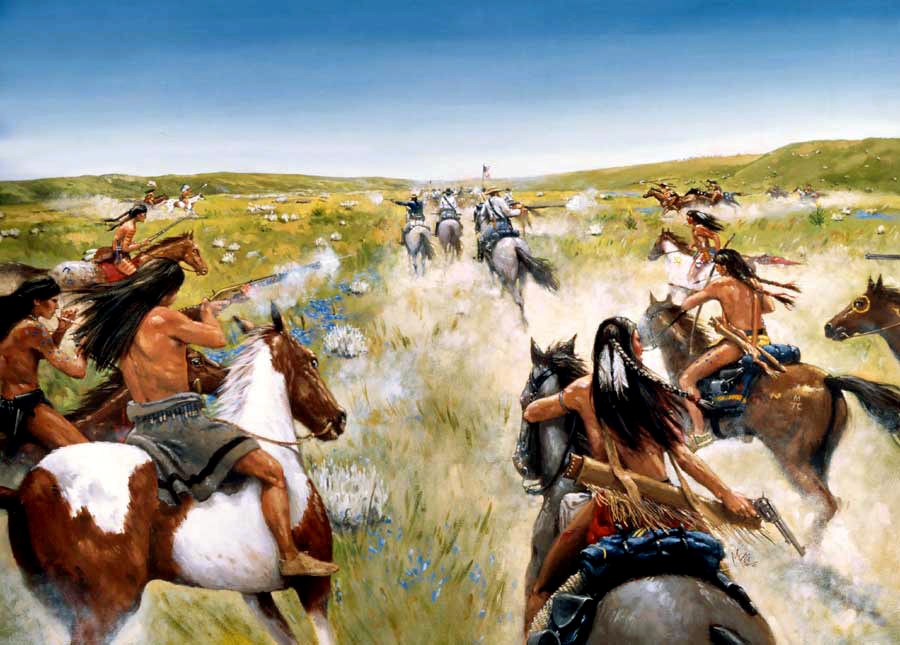
The Lakota and Cheyenne village lay in the broad river valley bottom, just west of the Little Bighorn River. As instructed by his commanding officer, Reno crossed the river about two miles south of the village and began advancing downstream toward its southern end. Though initially surprised, the warriors quickly rushed to fend off Reno’s assault. Reno halted his command, dismounted his troops, and formed them into a skirmish line, which began firing at the warriors who were advancing from the village. Mounted warriors pressed their attack against Reno’s skirmish line and soon endangered his left flank. Reno withdrew to a stand of timber beside the river, which offered better protection. Eventually, Reno ordered a second retreat, this time to the bluffs east of the river. The Sioux and Cheyenne, likening the pursuit of retreating troops to a buffalo hunt, rode down the troopers. Soldiers at the rear of Reno’s fleeing command incurred heavy casualties as warriors galloped alongside the fleeing troops and shot them at close range, or pulled them out of their saddles onto the ground.
Reno’s now shattered command crossed back over the Little Bighorn River and struggled up steep bluffs to regroup atop high ground to the east of the valley fight. Benteen had found no evidence of Indians or their movement to the south and had returned to the main column. He arrived on the bluffs in time to meet Reno’s demoralized survivors. A messenger from Custer previously had delivered a written communication to Benteen that stated, “Come on. Big Village. Be Quick. Bring Packs. P.S. Bring Packs.” An effort was made to locate Custer after heavy gunfire was heard downstream. Led by Capt. Weir’s D Company, troops moved north in an attempt to establish communication with Custer.
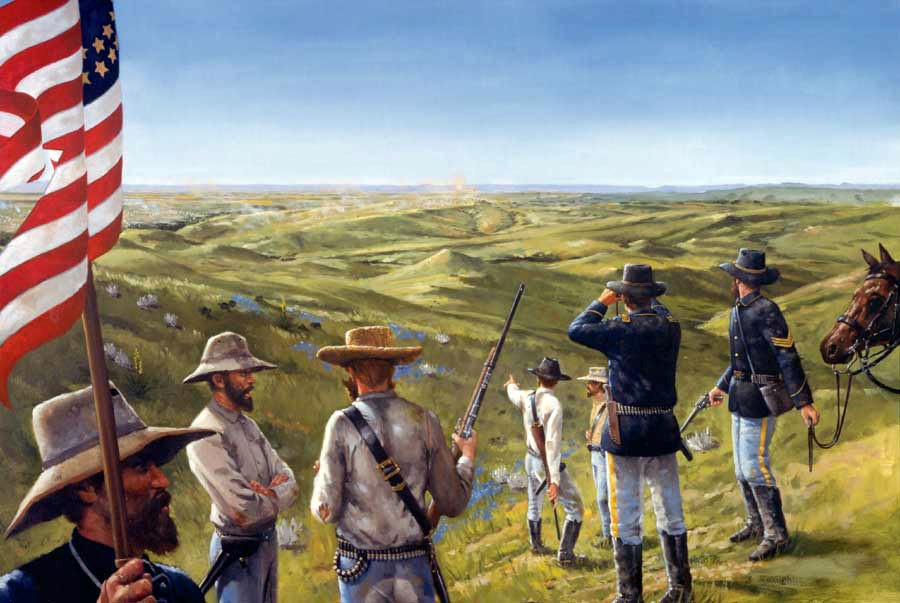
Assembling on a high promontory (Weir Point) a mile and a half north of Reno’s position, the troops could see clouds of dust and gun smoke covering the battlefield. Large numbers of warriors approaching from that direction forced the cavalry to withdraw to Reno Hill where the Indians held them under siege from the afternoon of June 25, until dusk on June 26. On the evening of June 26, the entire village began to move to the south.
The next day the combined forces of Terry and Gibbon arrived in the valley bottom where the village had been encamped. The badly battered and defeated remnant of the 7th Cavalry was now relieved. Scouting parties, advancing ahead of Gen. Terry’s command, discovered the dead, naked, and mutilated bodies of Custer’s command on the ridges east of the river. Several members of George Armstrong Custer’s family were also killed at the Battle of the Little Bighorn, including two of his brothers, his brother-in-law, and a nephew.
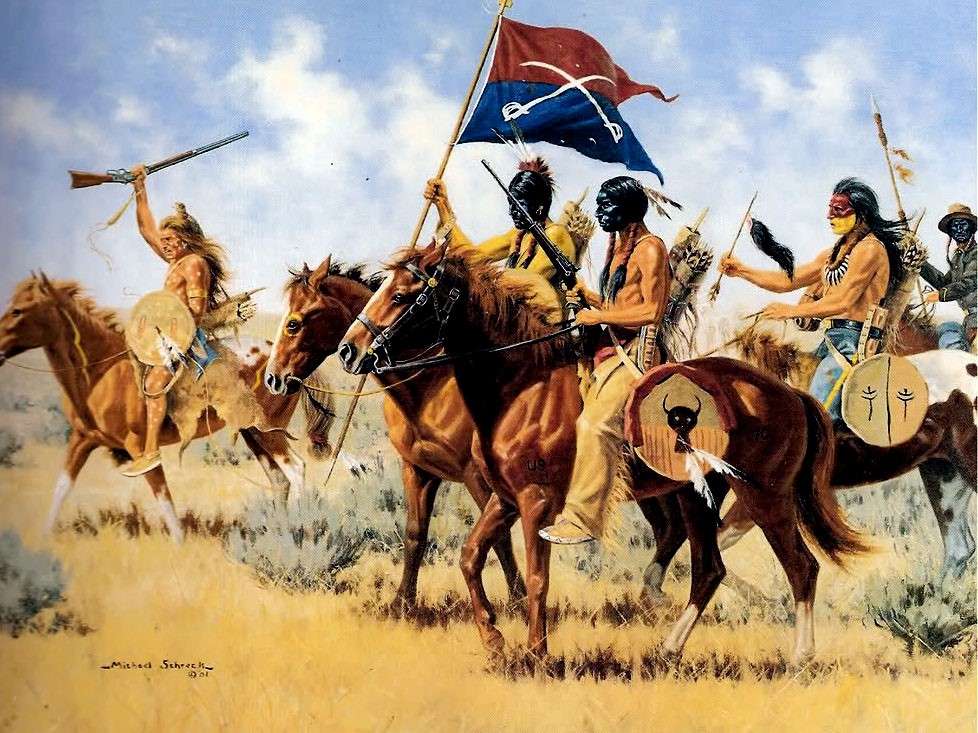
Custer’s Final Movements Expose a Desperate Last Stand
Exactly what happened to Custer’s command never will be fully known. From Indian accounts, archaeological finds, and positions of bodies, historians can piece together the Custer portion of the battle, although many answers remain elusive.
It is known that, after ordering Reno to charge the village, Custer rode northward along the bluffs until he reached a broad coulee known as Medicine Tail Coulee, a natural route leading down to the river and the village. Archaeological finds indicate some skirmishing occurred at Medicine Tail ford. For reasons not fully understood, the troops fell back and assembled on Calhoun Hill, a terrain feature on the ridges. The warriors, after forcing Reno to retreat, now began to converge on Custer’s maneuvering command as it forged north along what, today, is called Custer or Battle Ridge.
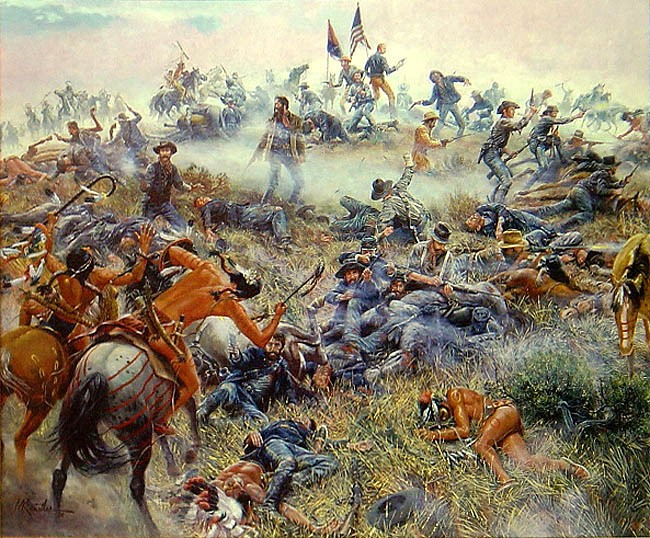
Dismounting at the southern end of the ridge, companies C and L appear to have put up stiff resistance before being overwhelmed. Company I perished on the east side of the ridge in a large group, the survivors rushing toward the hill at the northwest end of the long ridge. Company E may have attempted to drive warriors from the deep ravines on the west side of the ridge or attempted to make their own last stand there, before being consumed in fire and smoke deep in the ravines. Company F may have tried to fire at warriors on the flats below the area now known as a National Cemetery before being driven to the Last Stand Site.
About 40 to 50 men of the original 210 were cornered on the hill where the monument now stands. Hundreds of Lakota and Cheyenne warriors surrounded them. Toward the end of the fight, soldiers, some on foot, others on horseback, broke out in a desperate attempt to get away. All were pulled down and killed in a matter of minutes. The warriors quickly rushed to the top of the hill, cutting, clubbing, and stabbing the last of the wounded. Superior numbers and overwhelming firepower brought the Custer portion of the Battle of the Little Bighorn to a close.
The battle was a momentary victory for the Sioux and Cheyenne. The total U.S. casualty count included 268 dead and 55 severely wounded (six of whom died later from their injuries), including four Crow Indian scouts and two Pawnee Indian scouts. Native American casualty estimates have differed widely, from as few as 36 dead (from Native American listings of the dead by name) to as many as 300.
Custer’s Defeat Drives the Final Sioux Resistance
Gen. Phil Sheridan now had the leverage to put more troops in the field. Lakota Sioux hunting grounds were invaded by powerful Army expeditionary forces, determined to pacify the Northern Plains and to confine the Lakota and Cheyenne to reservations. Most of the declared “hostiles” had surrendered within one year of the fight or infiltrated back to the reservation, and the Black Hills were taken by the U.S. without compensation.
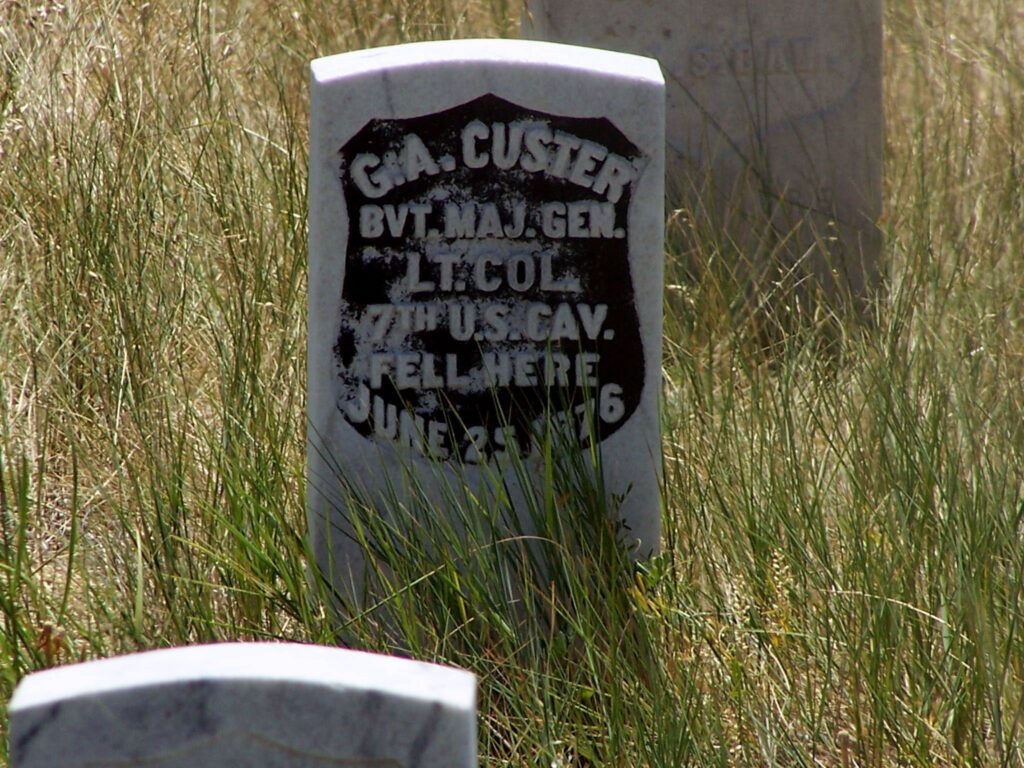
The respite brought by the victory was brief for the warring Sioux. The rest of the United States regulars arrived and chased the Sioux for the next several months. By October, much of the resistance had ended. Crazy Horse had surrendered, but Sitting Bull and a small band of warriors escaped to Canada. Eventually, they returned to the United States and surrendered because of hunger. Within five years, almost all of the Sioux and Cheyenne would be confined to reservations.
In 1878, the Army awarded 24 Medals of Honor to participants in the fight on the bluffs for bravery, most for risking their lives to carry water from the river up the hill to the wounded. While some Indian accounts claimed that some soldiers had committed suicide to prevent capture (out of a belief they would be tortured, which seems to have been born out by the later discovery of some dismembered and burned body parts in the abandoned encampment along the river), most accounts noted the most accounts noted the bravery of the majority of soldiers who fought to the death.
Read About Other Battlefield Chronicles
If you enjoyed learning about the Custer’s Last Stand, we invite you to read about other battlefield chronicles on our blog. You will also find military book reviews, veterans’ service reflections, famous military units and more on the TogetherWeServed.com blog. If you are a veteran, find your military buddies, view historic boot camp photos, build a printable military service plaque, and more on TogetherWeServed.com today.
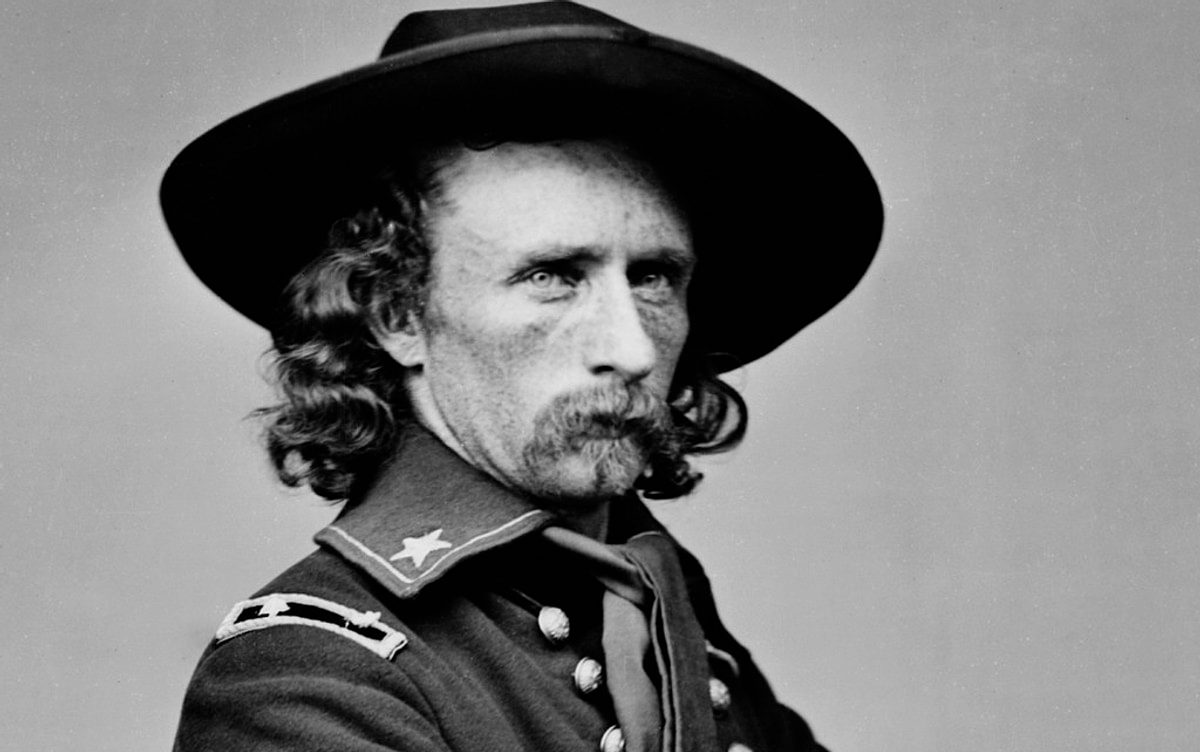
The crow scouts were dismissed by Custer right after he was shown the dust made by the Indian horses. Custer’s head scout returned and reported this and told of watching the whole battle from a distance.
Custer’s body was not scalped or mutalated for he had Indian relatives of his Indian wife that did not allow this to happen.
The commanders were told to converge on the Little Big Horn area, but Gen. Crook attacked from the south two days
earlier because he wanted the glory. Crook’s unit ran out of ammo and had to retreat back to the south.
Pack train had previously been left behind, with Benteen, because it was bogged down in a swampy area and the pack mules were laying down to cool off. Custer only split his unit twice making three parts not the four stated.
Reno never made it to the trees for there were Indians on foot doing a rearguard action that stopped him.
Another detail that would have helped the reader to get a grasp of the situation was to mention that the Little Big Horn
River flows North.
Once Custer was pinned down, he sent several squads a number of times with no success, to try to get water for his men like that was done by the Reno/Benteen hold out area East of the river on the bluff.
I have studied these facts and spent 3 days covering the battlefield, taking in many of the tours.
These updates should be inserted or attached.
The above comment has several issues with it.
Essentially, what did the 7th in was:
The Indians did not scatter as they traditionally did upon encountering Troops. The terrain and Custer’s Trooper depositions allowed the Indians to get too close. Their new found cohesion and numbers simply overwhelmed Custer.
Secondly, Custer didn’t respond to this change in the Tactical Situation. His deployments from Calhoun Hill to Keogh were too far apart and left a gap that Crazy Horse exploited. This doomed them.
After defeating Custer, the Indians only half heartedly tried to defeat Reno/Benteen. Many were tired, or were packing up to leave.